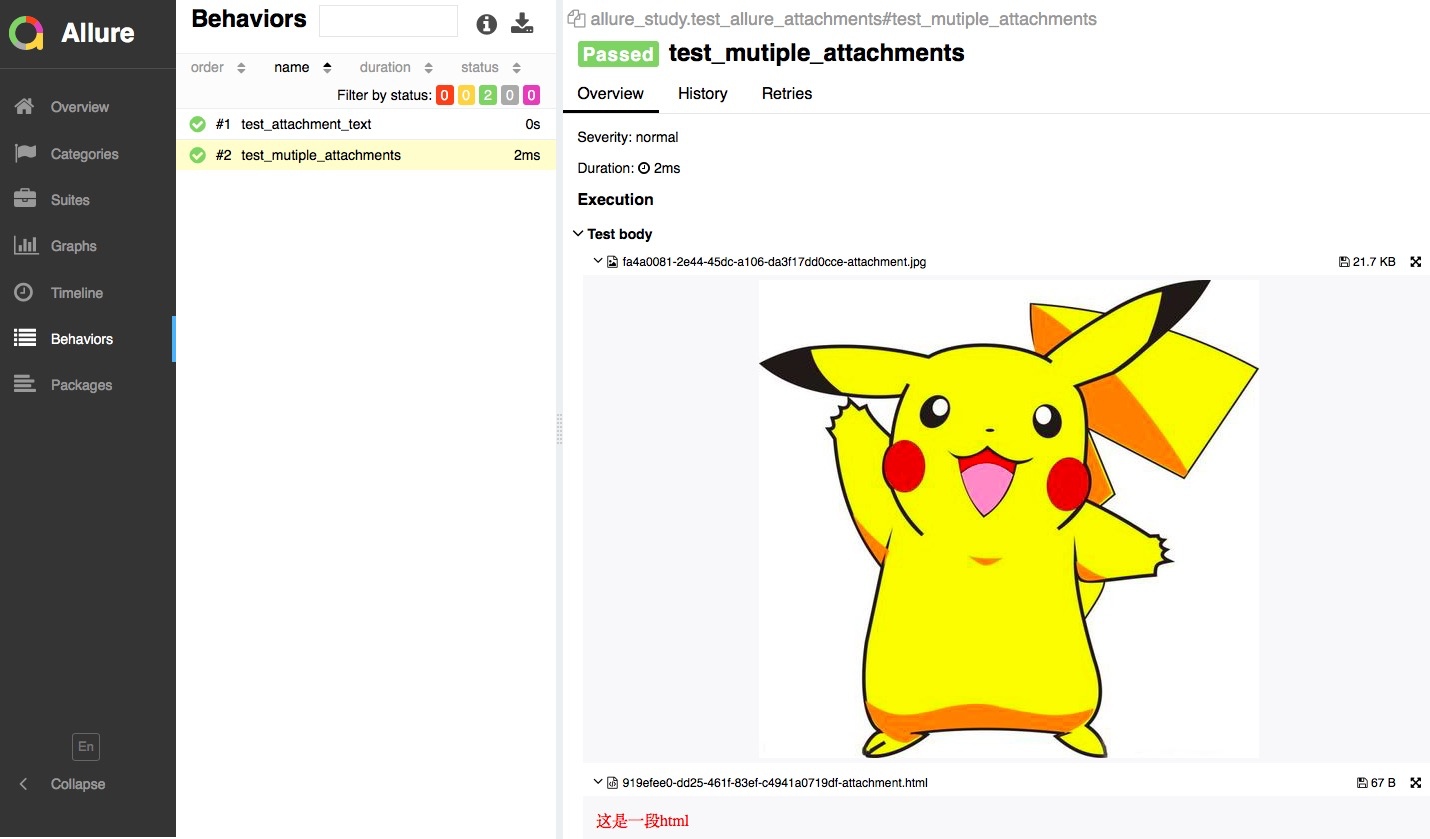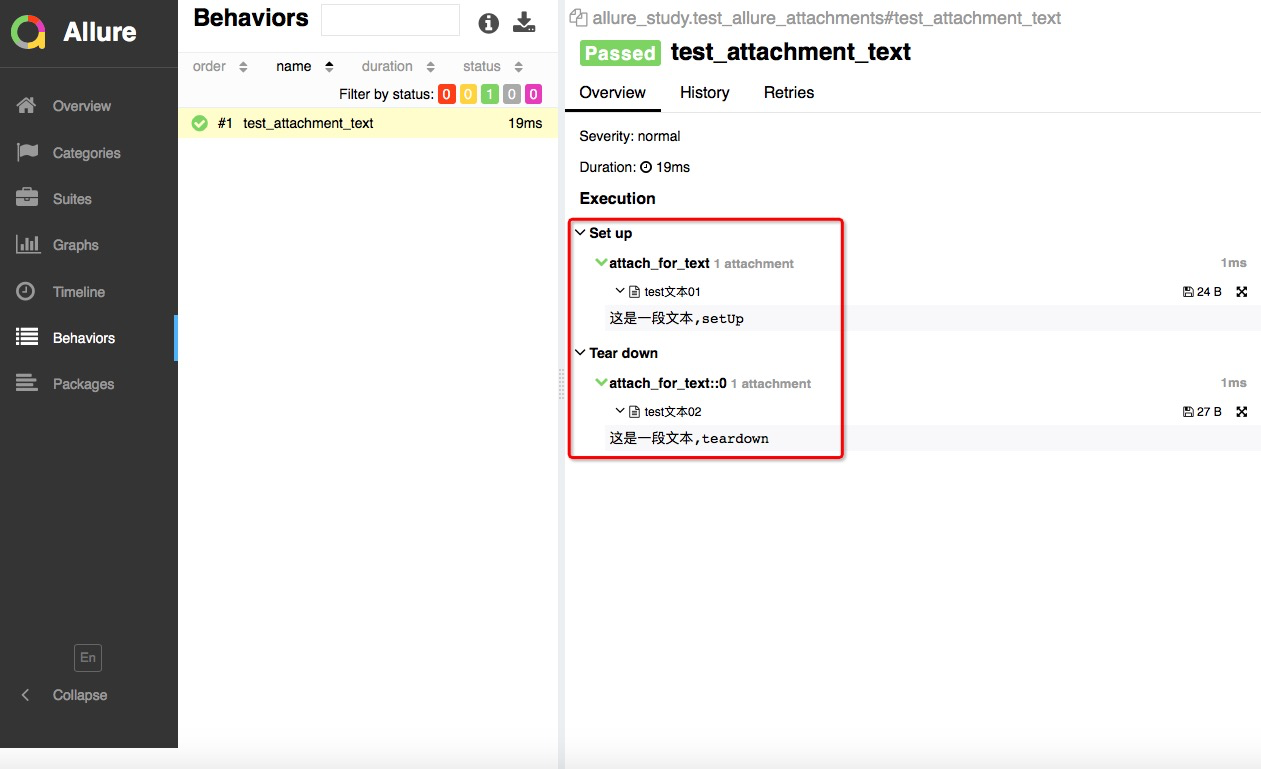pytest(19):allure的特性,@allure.step()、allure.attach的详细使用
前言
allure除了支持pytest自带的特性之外(fixture、parametrize、xfail、skip),自己本身也有强大的特性可以在pytest中使用
@allure.step
- allure报告最重要的一点是,它允许对每个测试用例进行非常详细的步骤说明
- 通过 @allure.step() 装饰器,可以让测试用例在allure报告中显示更详细的测试过程
示例代码
import allure
@allure.step("第一步")
def test_passing_step():
pass
@allure.step("第二步")
def test_step_with_nested_steps():
pass
@allure.step("第三步")
def test_nested_step():
pass
@allure.step("第四步{0},{arg2}")
def test_nested_step_with_arguments(arg1, arg2):
pass
@allure.step("第五步")
def test_with_nested_steps():
pass
测试用例在allure上的显示

知识点
- step() 只有一个参数,就是title,你传什么,在allure上就显示什么
- 可以像python字符串一样,支持位置参数和关键字参数 {0},{arg2},可看第四步那里,如果函数的参数没有匹配成功就会报错哦
- step() 的使用场景,给我感觉就是,当方法之间嵌套会比较有用,否则的话只会显示一个步骤,
allure.attach(挺有用的)
作用:allure报告还支持显示许多不同类型的附件,可以补充测试结果;自己想输出啥就输出啥,挺好的
语法: allure.attach(body, name, attachment_type, extension)
参数列表
- body:要显示的内容(附件)
- name:附件名字
- attachment_type:附件类型,是 allure.attachment_type 里面的其中一种
- extension:附件的扩展名(比较少用)
allure.attachment_type提供了哪些附件类型?
TEXT = ("text/plain", "txt")
CSV = ("text/csv", "csv")
TSV = ("text/tab-separated-values", "tsv")
URI_LIST = ("text/uri-list", "uri")
HTML = ("text/html", "html")
XML = ("application/xml", "xml")
JSON = ("application/json", "json")
YAML = ("application/yaml", "yaml")
PCAP = ("application/vnd.tcpdump.pcap", "pcap")
PNG = ("image/png", "png")
JPG = ("image/jpg", "jpg")
SVG = ("image/svg-xml", "svg")
GIF = ("image/gif", "gif")
BMP = ("image/bmp", "bmp")
TIFF = ("image/tiff", "tiff")
MP4 = ("video/mp4", "mp4")
OGG = ("video/ogg", "ogg")
WEBM = ("video/webm", "webm")
PDF = ("application/pdf", "pdf")
allure.attach的用法一:
语法:
allure.attach(body, name, attachment_type, extension)
参数解释:
- body:要写入附件的内容;
- name:附件名字;
- attachment_type:附件类型,是allure.attachment_type其中的一种;
- extension:附件的扩展名;
allure.attach的用法二:
语法:
allure.attach.file(source, name, attachment_type, extension)
参数解释:
- source:文件路径,相当于传一个文件;
- name:附件名字;
- attachment_type:附件类型,是allure.attachment_type其中的一种;
- extension:附件的扩展名;
allure.attach使用举例:
1、测试用例中添加文本附件:
@pytest.fixture()
def attach_for_text():
allure.attach(body="这是一段文本,setUp", name="test文本01", attachment_type=allure.attachment_type.TEXT)
yield
allure.attach(body="这是一段文本,teardown", name="test文本02", attachment_type=allure.attachment_type.TEXT)
def test_attachment_text(attach_for_text):
pass
if __name__ == '__main__':
pytest.main(['-s', 'test_allure_attachments.py'])
执行命令:

查看测试报告展示效果:
从测试报告中可以看到,我们通过使用allure.attach指定attachment_type=allure.attachment_type.TEXT,往测试用例中添加了一段文本。
2、测试用例中添加图片以及HTML:
import pytest
import allure
def test_mutiple_attachments():
allure.attach.file("./pytest_study/image/pikaqiu.jpg", attachment_type=allure.attachment_type.JPG)
allure.attach("<html><body><font color='red'>这是一段html</font></body></html>",
attachment_type=allure.attachment_type.HTML)
if __name__ == '__main__':
pytest.main(['-s', 'test_allure_attachments.py'])
执行命令:
查看测试报告展示效果:

从上面的报告中可以看到:
我们通过allure.attach.file()指定attachment_type=allure.attachment_type.JPG的方式往测试报告中添加了一张图片;
通过allure.attach()指定attachment_type=allure.attachment_type.HTML的方式往测试报告中添加了一段HTML内容;


